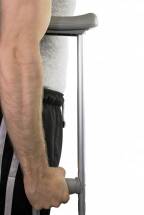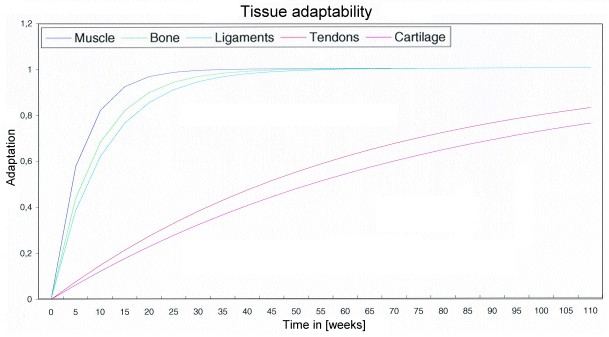Before committing to a cartilage repair procedure, it is important to understand the timelines of healing.
 First published in 2008, and reviewed August 2023 by Dr Sheila Strover (Clinical Editor)
First published in 2008, and reviewed August 2023 by Dr Sheila Strover (Clinical Editor)
Articular cartilage repair rehabilitation
Why is rehabilitation after articular cartilage repair so important?
Rehabilitation following ANY articular cartilage repair procedure is long and demanding. There are many variations in rehabilitation protocols so it is not possible to discuss specific guidelines in this review. If you are planning to have, or have had, an articular cartilage repair you should be given a rehabilitation programme based on the surgical procedure and your individual needs. This section will provide you with an insight into why rehabilitation is so important and give you an understanding of the general principles of rehabilitation after articular cartilage repair.
General principles of articular cartilage rehabilitation
There are many factors that need to be taken into account when considering rehabilitation following articular cartilage repair but the main ones are:
- The location of your defect.
- The size of your defect.
- What articular cartilage repair procedure you have had.
- If you have had any other surgical procedures such as an osteotomy or an anterior cruciate ligament reconstruction.
The overall aim of the rehabilitation process is to restore your function whilst protecting and facilitating the adaptation of the repair tissue.
Whichever articular cartilage repair procedure is carried out there is always the issue of the delicacy of the repair tissue after the surgery. In an ACI the repair tissue can be just cells in a fluid under a thin membrane and for microfracture the repair tissue is initially just a blood clot. On one hand there is a need to protect the repair tissue but on the other hand controlled movement is essential for the health of the new repair tissue and for restoring function. So this is very much a double-edged sword and this is one of the reasons why you need to be on the same wavelength as your surgeon and therapist with regards to rehabilitation and make sure you stick to the guidelines you are given. Even if you think you are doing well and don't have symptoms it doesn't mean that your repair is ready to move on. Communication is the key.
Early controlled movement is important for articular cartilage repair but any excessive loading will increase the risk of damage to the delicate repair tissue. In order to minimise this risk you need to know a bit more about the two main ways in which you can stress your cartilage repair.
- Cyclical compressive stress is when one articular surface squeezes the articular cartilage on the opposite articular surface for a short time and then the pressure is released allowing the compressed articular cartilage to go back to its original volume. This is good for the articular cartilage as this is the mechanism by which it is naturally nourished in the joint and compressive stress helps the cartilage to adapt and increase in thickness.
- Shear stress is when one articulating surface slides across the other. Shear stress should be avoided as much as possible as it disrupts the articular cartilage fibres resulting in wear.
There are a number of ways in which your rehabilitation programme will be designed so that your repair receives a good level of compressive stress but not the excessive shear stress that could cause damage to the repair.
In the early stages after surgery, especially, in the USA you will probably need to use a continuous passive motion (CPM) machine which takes your leg passively through a controlled range of movement. If you aren't given a CPM machine don't worry, access to these is limited in some countries and where this is the case you will be given some gentle exercises to do such as a facilitated heel slide.
 For the first few weeks after your surgery you may have restrictions on the amount of weight you can put through your leg and everyone who has had cartilage repair surgery will be on crutches initially. Some people will also be in a brace for a number of weeks that limits the amount you are able to bend your knee. These restrictions will be dependent on, in particular, where your articular cartilage damage was as the joint mechanics are different between the tibiofemoral joint and the patellofemoral joint. So just because someone has had the same articular cartilage repair procedure to you they may have a very different rehabilitation program due to the difference in location of their defect.
For the first few weeks after your surgery you may have restrictions on the amount of weight you can put through your leg and everyone who has had cartilage repair surgery will be on crutches initially. Some people will also be in a brace for a number of weeks that limits the amount you are able to bend your knee. These restrictions will be dependent on, in particular, where your articular cartilage damage was as the joint mechanics are different between the tibiofemoral joint and the patellofemoral joint. So just because someone has had the same articular cartilage repair procedure to you they may have a very different rehabilitation program due to the difference in location of their defect.
Throughout your rehabilitation program your surgeon and therapist will advise you on which exercises are more likely to produce shear stress on your articular cartilage repair site and which exercises will help to provide an optimal amount of compressive stress to facilitate cartilage.
The surgery for articular cartilage repair procedures are one day - rehabilitation can last up to 2 years or longer. The length of time for rehabilitation has implications for your normal every day life. You should be aware of these BEFORE you decide to go ahead with articular cartilage repair surgery. Many of the articular cartilage repair procedures will need you to be non weight bearing or only partially weight bearing for a period of time. This means that you will be on crutches and have reduced mobility. You will need to consider child care, transportation, time off work, getting around the house, shopping, cooking and other activities of daily life. Going through an articular cartilage repair procedure doesn't just affect you the patient, it affects everyone around you too - family, friends and work colleagues. Therefore, it is always a good idea to take someone close to you along to the appointments with the surgeon before the surgery so they can appreciate the postoperative implications.

